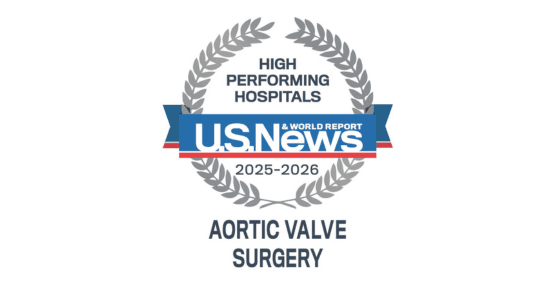Types of Aneurysm Repair
The type of aneurysm repair for each patient is unique. No one method is better than the other; it is simply that one (or more) technique is better for a particular patient. UChicago Medicine's aortic team has expertise is each procedure so that we can provide complete aneurysm treatment. Our team will evaluate you individually before determining which procedure is the best and safest for you.
Open Aneurysm Repair
With an open aneurysm repair, or standard repair, an incision is made near the aortic aneurysm to provide direct sight of the aneurysm during the procedure. During an open repair, our surgeons replace the weakened part of the aorta and sew an artificial tube-shaped graft into place to allow proper blood flow. Depending on the case, patients typically spend 5-7 days in the hospital and fully recover within six weeks to three months.
Post open repair, our team will require a yearly ultrasound, in addition to ordering CT scans of the chest/abdomen/pelvis every five years, to check the repair and assess if any new aneurysms have developed.
If your aneurysm ruptures, or breaks open, it can cause life-threatening bleeding inside your body. If your aneurysm is small, or slow-growing, your health care provider may suggest watching it closely without treatment at first. If the aneurysm reaches a certain size, however, the risk it will rupture increases. You may need to have it repaired.
During open or surgical repair of an abdominal aortic aneurysm, your doctor will make a large incision in your belly to reach your aorta. Your surgeon cuts open your aneurysm, and sews a graft made of strong material into place.
Before the procedure: Before the procedure, you may have a physical exam, blood tests, and certain heart tests. You'll be asked to not eat or drink for at least eight hours before your appointment. Tell your health care provider about all medications and supplements you take, and if you have any allergies.
Your health care provider will explain what happens during the procedure. He or she will also talk with you about any risks or complications that may happen. This is the time to ask any questions you have about the procedure. You'll be asked to sign a consent form that gives your health care provider permission to do the procedure. Read the form carefully, and ask questions if anything is not clear.
What to expect: You are given general anesthesia to make you sleep through surgery. Your surgeon makes a long incision in your belly to reach the aneurysm. The surgeon places a clamp on the aorta, above and below the site of the aneurysm. This temporarily stops the flow of blood. Your surgeon cuts open your aneurysm, and sews a graft made of strong material into place.
Your surgeon removes the clamps, and sews the aorta back together. The surgeon will close the incision with staples, or stitches. This surgery may take three to six hours. You can expect to stay in the hospital for a week, or longer, after your surgery.
After the procedure: For the first few days after your surgery, you will be in the intensive care unit, or ICU. Tubes will give you nourishment, help you breathe, and drain fluids from your body. As you heal, your health care providers will gradually remove the tubes. During this time, nurses and specialists will help you care for your incision, and start walking. You'll also get medication to control pain.
Once you're home from the hospital, follow all instructions from your health care provider about the care of your incision, your medications, and your return to activity. Make sure to keep all your follow-up appointments. Don't be surprised if it takes you several months to feel fully recovered.
Things to remember: Large or fast growing aneurysms are at risk of rupturing, and need treatment. Your surgeon will repair the aneurysm by replacing it with a graft. It may take several months before you feel fully recovered from surgery.
What we have learned: During open repair of an aneurysm, your surgeon cuts away the aneurysm and replaces it with a graft. True or false? The answer is true. A graft made of a strong material is sewn into the aorta, to replace the damaged area of the blood vessel. Small or slow growing aneurysms need surgical repair. True or false? The answer is false. Your health care provider may suggest watching and waiting before recommending surgery.
Endovascular Aneurysm Repair
For endovascular repairs, our physician inserts a long, thin catheter into a vessel in the groin and threads it up into the aorta. A small, flexible tube — called a stent or endograft — is guided through the catheter and inserted into the aorta to strengthen it and reinforce the weakened section of the aorta to prevent rupture.
Patients who undergo endovascular aneurysm repair will need regular follow-up visits for CT scans to make sure that the graft is working properly. Our team offers the NEXUS® Aortic Arch Stent Graft System for aortic arch aneurysms and dissections, providing a minimally invasive option for patients with more complex conditions to deliver a simple, controlled 2-stage procedure for consistency, reliability and long-term success.
Our experts will work with you to select the best option to address your specific aortic condition.
Abdominal Aortic Aneurysm, Endovascular Repair: The aorta is the main blood vessel in your body. It carries oxygen-rich blood from your heart to the rest of your body.
The ascending aorta begins at your heart and arches toward your back. The thoracic aorta travels down along your spine toward your belly. The abdominal aorta starts near your kidneys and ends in your pelvis. There, it divides into two arteries that go down your legs.
An aortic aneurysm is a weak spot in your aorta that bulges or balloons outward. Aortic aneurysm is a serious medical condition. An aneurysm that ruptures or tears can cause uncontrolled bleeding inside your body and death.
If your aneurysm is small or slow growing, your health care provider may suggest watching it closely. But once your aneurysm reaches a certain size, the chances that it will rupture increase. And you'll need to have it repaired.
Depending on the size and location of your aneurysm, you'll either have open surgery or an endovascular repair. An endovascular repair uses two small incisions in your groin. This procedure may be recommended if you are older or have other health problems that would make recovery from open surgery more difficult.
Before the procedure: Your provider will explain what happens during an endovascular repair. He or she will also talk with you about any risks or complications that may happen. This is the time to ask any questions you have.
You'll be asked to sign a consent form that gives your health care provider permission to do the procedure. Read the form carefully. And ask questions if anything is not clear.
Your provider will also give you instructions about how to prepare for your surgery. Don't eat or drink anything after midnight the day before your surgery. Tell your health care provider about all of the medications and supplements you take and if you have any allergies. Ask your health care provider ahead of time if there are any medications you should stop taking before your surgery.
What to expect: You're given medication to help you relax and to prevent pain. You may be given general anesthesia to make you sleep. Or you may have epidural anesthesia. This medication blocks the pain in the area where the surgeon will work. An IV line is put into a vein in your arm or hand to supply fluids and medications.
Once you are asleep or the area is numb, your surgeon makes a small incision in your groin. He or she then places a thin, flexible tube called a catheter into an artery in your leg. He or she will guide the catheter to the aneurysm with the help of special X-rays.
Your surgeon uses the catheter to place the graft inside your aneurysm. A thin metal brace called a stent is expanded inside your artery. This holds the graft in place. The graft and stent reinforce the weakened area. Over time, your aneurysm may shrink.
After the procedure: After the procedure, you'll be taken to your hospital room where you will be closely watched. When your health care provider says it's OK to leave the hospital, you will need to have an adult family member or friend drive you home. Generally, an endovascular repair requires a much shorter hospital stay.
Once you're home from the hospital, follow all instructions from your health care provider about the care of your incision, your medications, and return to activity. Because your surgeon doesn't remove the aneurysm during an endovascular repair, you will need to have your aneurysm checked on a regular basis. There is still a small chance that your aneurysm will continue to grow or rupture. It's also possible for the graft to move.
Things to remember: Endovascular aneurysm repair uses catheters and small incisions to place a stent graft inside your aneurysm. The graft is permanent. Even after your aneurysm is repaired, you will still need regular follow-up testing.
What we have learned: Endovascular aneurysm repair requires a large incision in your chest, true or false? The answer is false. This procedure uses two small incisions in the groin.
The graft is put in place temporarily until another procedure can be done, true or false? The answer is false. The graft is permanent.
Hybrid Aneurysm Repair
Because there are aneurysms that cannot be repaired through endovascular techniques alone, our vascular surgeons also offer hybrids repairs — featuring a combination of endovascular stenting and open repair. Often, hybrid procedures can be custom designed for each patient in an effort to decrease the size of the incision and duration of the procedure, ultimately improving recovery and ensuring the best possible outcome.Aortic Diseases We Treat

Nationally Ranked in Cardiology, Heart Surgery and Vascular Surgery
According to U.S. News & World Report's 2025-26 Rankings

High Performing in Aortic Valve Surgery
According to U.S. News & World Report's 2025-26 Rankings
Nationally Ranked in Cardiology, Heart Surgery and Vascular Surgery

Find an Aortic Disease Specialist Near You
Request an Appointment
We are currently experiencing a high volume of inquiries, leading to delayed response times. For faster assistance, please call 1-773-702-6128 to schedule your appointment.
If you have symptoms of an urgent nature, please call your doctor or go to the emergency room immediately.
* Indicates required field
